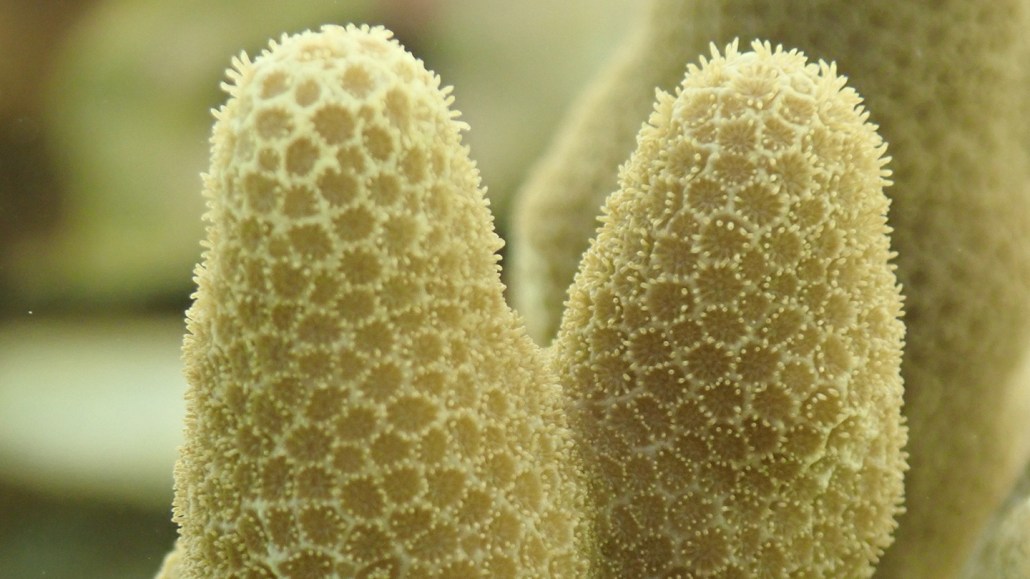Adult corals have been frozen and revived for the first time
The deep freeze could help corals survive our changing climate

This finger coral, Porites compressa, is named for its blunt branches. Pieces of the coral collected off the coast of Hawaii have successfully been frozen and revived. The research offers hope that the world’s corals could be preserved as the oceans warm and acidify.
Claire Lager, Smithsonian
Share this:
- Share via email (Opens in new window) Email
- Click to share on Facebook (Opens in new window) Facebook
- Click to share on X (Opens in new window) X
- Click to share on Pinterest (Opens in new window) Pinterest
- Click to share on Reddit (Opens in new window) Reddit
- Share to Google Classroom (Opens in new window) Google Classroom
- Click to print (Opens in new window) Print
By Nikk Ogasa
This is another in our series of stories identifying new technologies and actions that can slow climate change, reduce its impacts or help communities cope with a rapidly changing world.
A frosty rescue plan could save corals that are threatened by warming seas.
Scientists have for the first time safely frozen and revived small colonies of mature corals. But more work will be needed to ensure their long-term survival.
Researchers described their success August 23 in Nature Communications.
Freezing living organisms for safekeeping is called cryopreservation. Scientists hope this process could save corals from extinction. Corals are at risk of dying off as the oceans heat up and acidify from human-caused climate change.
Researchers had already successfully frozen and revived coral larvae. These are the early life stages of coral. But collecting larvae has become more difficult. They are accessible only when corals spawn. That happens just a few nights each year, notes Liza Roger. She is a marine scientist at Arizona State University in Tempe. “That’s putting a lot of eggs in one basket.” What’s worse, she says, coral reproduction is struggling. Fewer larvae are surviving, due to warming seas.
One solution is instead to cryopreserve mature coral colonies. Adults are more accessible; they’re available year-round. And those preserved adults could be saved until humans can reverse climate warming. The coral could then help rebuild reef ecosystems in more hospitable seas.
But adult corals are harder to cryopreserve. It’s difficult to prevent ice formation in them. And ice damages coral tissues, a bit like ice cracking pipes in winter.
Matthew Powell-Palm works at Texas A&M University in College Station. As a thermodynamicist, he studies the relationships between heat and other forms of energy. His team experimented with freezing pea-sized pieces of a common Hawaiian finger coral (Porites compressa).
The first step: Remove microbes. They can interfere with preservation. The researchers used menthol and light to do this. Then, the coral fragments were sealed in rigid metal chambers filled with a special mix of chemicals. This chemical bath partially dried out the corals, which helped limit ice growth. Finally, the corals were plunged into liquid nitrogen. Being super-cold, it quickly dipped the corals’ temperature down to roughly -200° Celsius (-328° Fahrenheit).
Some water remained in the corals. But it didn’t expand into ice crystals. Instead, it solidified into a glassy form.
At such frigid temps, the animals’ life processes proceed at “an infinitesimally slow pace,” Powell-Palm says. In this way, he says, “You could preserve [living specimens] for hundreds, possibly thousands of years.”
The corals spent a couple of minutes in cryopreservation. But the real test came next. After being pulled from the nippy nitrogen, they were carefully thawed and allowed to recover. This took 24 hours. Then, the researchers measured how much oxygen the thawed corals were consuming. One day after thawing, these corals were alive and well.
The results are promising, but the team’s work isn’t finished, says Roger at Arizona State. The freezing process is hard on the corals. A few days after thawing, these animals were still stressed out. In fact, they were overrun and killed by bacteria that they normally can live in harmony with. So the next steps should be to help the corals survive longer-term, she says.
Powell-Palm is optimistic. Antibiotics might protect the recovering corals, he says. The right treatment could help the brave little coral crumbs thrive within whatever new world they’re revived.







